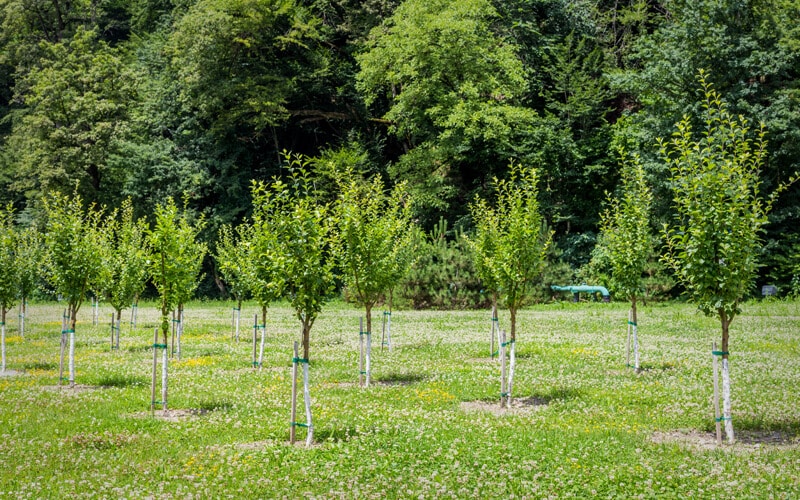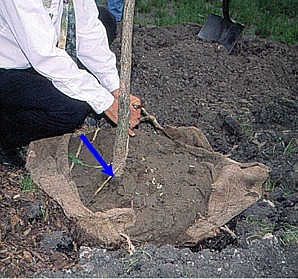
Planting a tree wrapped in burlap

In moist climates such as in the eastern US, treated (with copper) natural burlap can be left along the sides of the root ball because it typically rots in the soil. However, there are reports of natural, untreated burlap as well as treated burlap not decomposing in the drier parts of the country (regions receiving less than about 20 inches of annual precipitation). Therefore, it may be best to completely remove the burlap in these climates. This may be very difficult depending on how well rooted the tree is.
Regardless of location, burlap should be removed from the top of the ball so water can reach the root system without obstruction; removing burlap from the top also allows you to check for and treat root defects on top of the root ball. The concept of water wicking out of the soil through burlap exposed to the sun is unsubstantiated by research. Remove all artificial coverings on the outside of the root ball. Remove all string and strapping that is wrapped around and secured to the trunk.
It may be difficult to distinguish between natural and synthetic burlap. If so, burn a small portion with a match. Synthetic burlap often melts and smokes and may not produce a flame. A plastic goo remains following burning. Natural burlap usually burns with a flame and turns to ash.
Planting a tree in a wire basket

Some horticulturists recommend removing at least the top 12 to 18 inches (two or three levels) of wire from the root ball, or the entire basket. One to several minutes are required to remove the wire basket. Trees with the wire basket removed at planting often require staking, especially if the root ball is sandy, or the root system is not well established or is loose in the ball.
To remove the top portion of the basket, the top of the planting hole will have to be dug wider than the root ball. This extra hand digging creates the clearance needed to cut and remove the wire all around the root ball after it is installed in the planting hole.

To remove the entire wire basket at planting, first cut away the bottom half of the basket leaving the top half intact. Place the tree into the planting hole and fill in around the root ball with enough soil to stabilize the tree. Remove the top half of the basket and backfill to complete the planting job. After removing the lower portion of the wire basket, clayey or loamy root balls usually stay intact. Root balls with inadequate root systems, or those with very sandy soils may loose soil from the bottom of the ball when the tree is picked up and lowered into the planting hole. The tree is likely to shock and could die. Again, the tree will need to be staked when the basket is removed. Of course the staking will need to be removed about a year later.
If you are inclined to remove the top portion of the basket then consider doing so about one year after planting when roots have stabilized the tree. In either case (removing the basket at planting and staking vs. leaving the strapping and basket intact at planting and not staking) just like a tree planted from a container, a return trip is required about a year after planting to remove something from the tree. On balance, it sounds like you are better off leaving the basket intact at planting and planning on returning in a year to remove the top portion.
source: Planting balled and burlapped (B&B) or field-grown trees (University of Florida)
